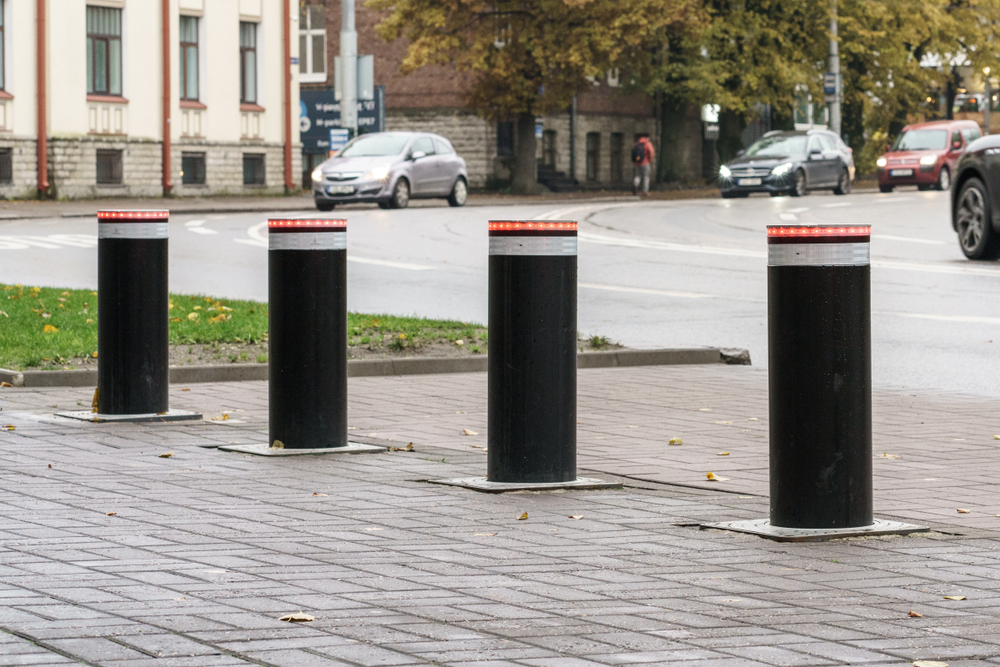Back to Basics is an article series that highlights important, but possibly overlooked, information facilities management professionals should know.

Bollards are short, mounted vertical posts that create a barrier to prevent vehicles from entering facilities, utilities, pedestrian areas, and sensitive components inside facilities. Facilities professionals should install bollards on their properties for asset protection and to increase facility security and safety, not just for pedestrians but also for facility occupants. Bollards can vary in shape, size, design, and price and can be used in commercial, industrial, educational, and governmental facilities.
Security Uses
Prevent Theft. Bollards can prevent smash-and-grab burglaries, which occur when a vehicle smashes through a shop window so the driver and passengers can steal goods quickly. The U.S. General Service Administration’s (GSA) Site Security Guide recommends that bollards be used with closed-circuit television (CCTV), appropriate lighting, vegetation, and other landscape elements to help deter criminal activity.
Stop Terrorist Attacks. In November 2021, the Security Industry Association (SIA) reported that President Joe Biden signed into law a bollard grant program providing $25 million over the next 5 years to prevent “pedestrian injuries and acts of terrorism in areas used by large numbers of pedestrians,” according to the legislation.
Protect Exterior Components. Consider using bollards for sensitive outdoor components, including water and electrical boxes, as well as gas and water meters, building corners, fire hydrants, and storage areas. The GSA also recommends that facilities managers ensure access to heating, ventilation, and air conditioning (HVAC) intakes is restricted using walls, plantings, and steep slopes.
Keep Inside Assets Safe. Bollards can be used to protect valuable assets inside stores, warehouses, and industrial facilities, including power supplies, support columns, refrigeration units, ATMs, escalators, and shelving, that could be hit by carts, platform trucks, floor polishers, mobility scooters, pallet jacks, forklifts, or other moving vehicles.
Safety Uses
Safeguard Facilities. In addition to protecting buildings, the Whole Building Design Guide (WBDG) recommends using bollards to protect pedestrian plazas, outdoor athletic facilities, playgrounds, bus stops, school surroundings, and biking and hiking trails, as vehicles could severely damage all these areas. The Storefront Safety Council (SSC) reports that vehicles crash into commercial buildings like retail stores, offices, bus stops, shopping centers, post offices, restaurants, and more about 100 times a day.
Protect People. To help reduce injuries and deaths, use bollards to provide a clear delineation between vehicular traffic and pedestrians, especially where pedestrian walkways connect to streets. The SSC reports that 16,000 people are injured and 2,500 die every year as a result of drivers careening into occupied facilities. The locations where these crashes happen most frequently are retail stores and restaurants.
Facilities that Should Consider Installing Bollards
- Educational facilities. Elementary, middle, and high schools; colleges; universities; and museums;
- Government buildings. Capitols, town halls, libraries, police stations, fire departments, ambulance garages, and courthouses;
- Industrial. Warehouses and industrial facilities with forklifts and other low-powered indoor vehicles;
- Transportation facilities. Airports, train stations, public transit depots, and parking garages; and
- Commercial. Indoor and outdoor shopping centers, retail, restaurants, stadiums, entertainment venues, and urban areas.
How Are Bollards Made?
“Bollards come in three primary materials,” explained Tom Ustach, a member of the Protective Guarding Manufacturers Association (ProGMA). “These are polymer, rubber, or steel. Some manufacturers also use a combination of those three materials as part of a bollard’s construction.”
1. Polymer (Plastic). Consider using polymer bollards to segregate travel routes, or install them in parking lots where they might only experience a glancing blow, as they’re good for low-speed collisions and can handle multiple impacts. Ensure there’s open space around them in case something topples them over.
2. Rubber. Rubber bollards are more durable than plastic and can be used for low-speed collisions both inside and outside. They aren’t as hard as steel and provide some flexibility. Like polymer bollards, rubber bollards should be used where there’s open space in case they topple over after impact.
3. Steel. Steel bollards can endure a high degree of impact at any height by different vehicle types and can protect outdoor seating and equipment outside from being struck by vehicles. If they experience a large impact, they will need to be replaced and should only be used outside. Additionally, they can be used to segregate walkways and can have a concrete core.
Learn More
Facilities professionals who want to increase security or safety on the inside and outside of their facilities, as well as those who occupy them, should consider installing bollards in addition to other security measures. To learn more, check out “8 Ways to Secure a Facility’s Perimeter” on Facilities Management Advisor.
